So you’ve just brought home your very first Bearded Dragon…Like many, you’re probably wondering wondering what to feed it, how much to feed, and how often to serve up meals.
It can be difficult and time consuming to scour the internet in search of the best articles and advice – so we took the liberty of gathering everything you’ll need to know about feeding bearded dragons.
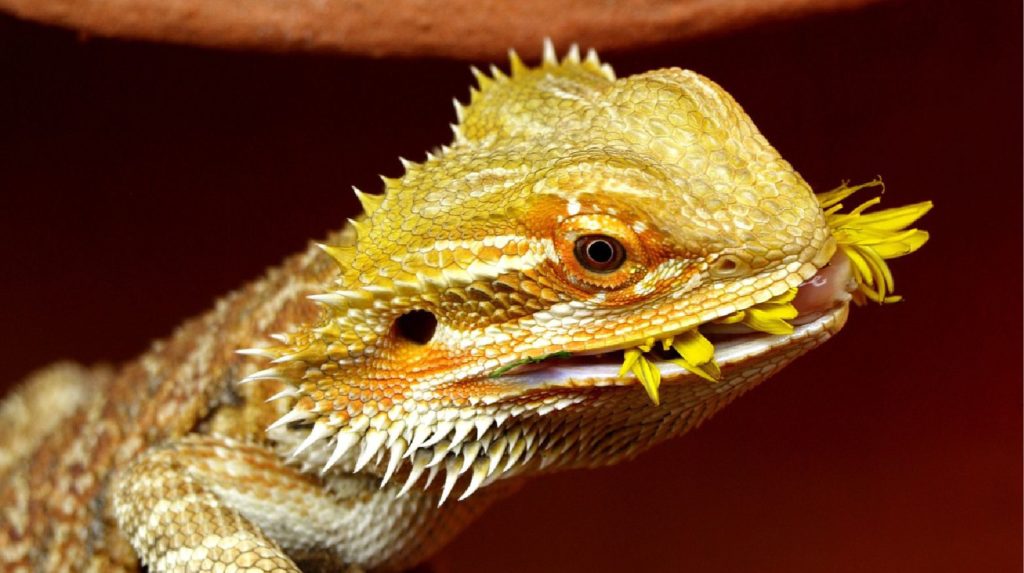
Keep reading for some of the best tips and recommendations you’ll need to keep your dragon’s diet and eating habits right on track.
Quick Navigation
Baby Bearded Dragon Diet
For younger bearded dragons, it is very important to keep their diets omnivorous with the right balance of plant and animal matter.
This ratio will change as dragons grow and mature – for baby dragons, bigger portions of leafy salads and smaller amounts of insects like Dubia Roaches or Phoenix Worms should be fed daily.
Best Insects for Baby Bearded Dragons
As we covered above, insects are the backbone of any baby bearded dragon diet. Here are a few types of insects that we recommend for baby beardies:
- Crickets
- Dubia Roaches
- Phoenix Worms
Best Greens for Baby Bearded Dragons
Although greens make up only 20% of a baby bearded dragon’s diet, they are still extremely important. Here are a few types of greed that we recommend:
- Collard Greens
- Turnip Greens
- Dandelion Greens
- Mustard Greens
Modifying Meals as Your Dragon Matures
Just like any animal, a bearded dragons’ diets change as it matures. After all, humans don’t eat the same foods their entire life, right?
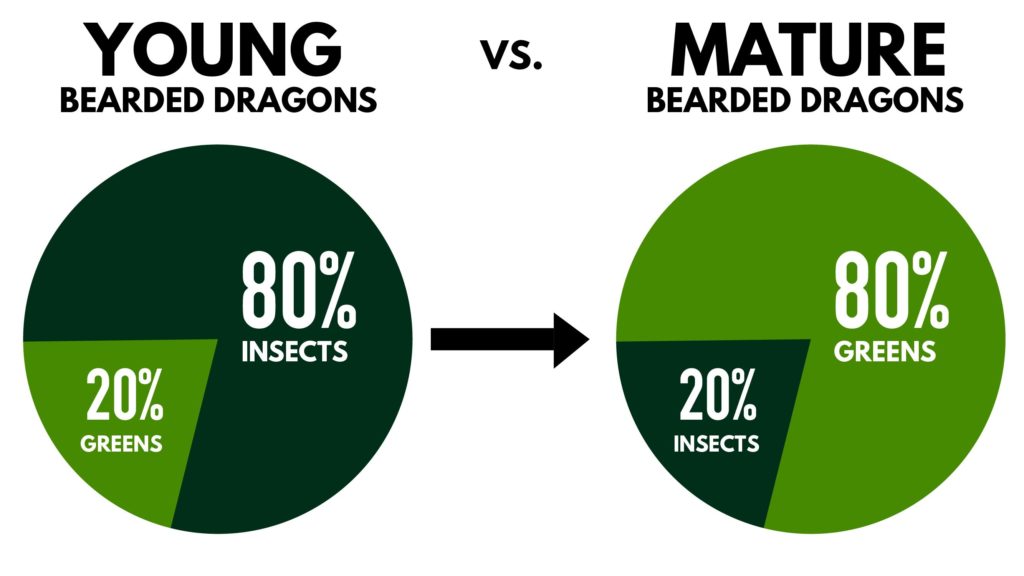
The ratio between insects and greens used to create a baby dragon’s diet will flip as they mature – adults will be better nourished by a diet consisting of 80% greens/veggies and 20% insects.
Large leafy salads and an assortment of veggies should be readily available to your bearded dragon every day (with a few worms or roaches added to the mix). Their eating schedule will also change with time, and we’ve got details below on what to expect and what to watch out for.
Much like baby bearded dragons, adults benefit from the occasional dusting of calcium and multivitamin supplements. We always recommend Zoo Med Repti Calcium.
Best Insects For Bearded Dragons
It is recommended that, when feeding a bearded dragon, each meal should consist primarily of fresh salads and live feeder insects (with some calcium sprinkled in and a multivitamin to top it all off). When looking for the right insects to feed your dragon, there is a wide variety of good staples to choose from.
1. Phoenix/Repti Worms
A top recommendation from many experts, Phoenix/Repti Worms are a healthy choice for feeder insects. They are the larvae of Black Soldier Flies (and though they are small in size, they make up for it with a hefty amount of calcium). Their shells are soft enough to make them easy to eat for bearded dragons young and old.
2. Dubia Roaches
Of a higher quality and nutritional value than crickets, Dubia Roaches (Blaptica dubia) and Discoid Roaches (Blaberus discoidalis) are both great choices depending on what’s available. These are definitely some of the healthiest options out there!
3. Crickets
Crickets definitely aren’t the best option – there’s nothing bad about them, they just aren’t the most nutritious insect to feed you bearded dragon. That said, crickets are readily available (at almost any pet store) and can made more nutritious by dusting them with calcium and multivitamins.
4. Silk Worms
The nutritional benefits of the Silk Worm can be helpful for bearded dragons of any age. They are packed full of protein and low in unhealthy fats. It is also recommended that you feed your dragon gravid (pregnant) female worms when available for extra nourishment.
5. Superworms
Various types of superworm include Hornworms, Butterworms, and Silk Worms (also listed above). Juvenile to adult bearded dragons can be fed any kind of superworm and enjoy them as treats with their meals.
Other Common (and safe) Worm Options
Wax worms, King worms, and earthworms also make great snacks for your Bearded Dragon. They may not pack as much of a nutritional punch, but dragons love them and they make for a great occasional snack.
Feeding the Proper Greens
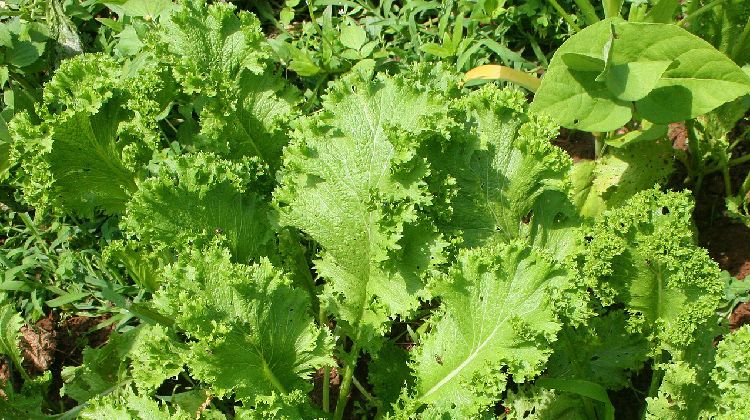
Providing daily salads full of dark, leafy greens is important in maintaining the health of your bearded dragon. Some recommendations for the most nutritional types of greens are
- Mustard Greens
- Collard Greens
- Dandelion Greens
- Turnip Greens
- Escarole (Chicory Greens
- Endive
- Coriander (occasionally)
You can also include Romaine Lettuce if you like, though only sparingly, as Romaine is limited in its nutritional value.
For a healthy supplement, sprinkle some Repashy’s Superveggie (the perfect dietary supplement for omnivores like your bearded dragon) over the salad and the other vegetables that accompany it.
In addition to the daily salads, your bearded dragon should also have a wide variety of vegetables made available to them every day. For younger bearded dragons, make sure that you chop up any vegetable really good – otherwise, you risk blocking up your pet.
Older bearded dragons should be able to handle slightly bigger chunks. Some of the best choices are green beans, acorn squash, butternut squash, yucca roots, konnayu (purple yams), and red peppers. With a sprinkling of Repashy’s Superveggie, any of the listed veggies will provide the perfect nourishment for your growing bearded dragon.
Other Options (Raw Only): There are several other common options out there, but some must specifically be served raw to be safest for your dragon to eat. These include bell peppers, shaved carrots, cabbage, lentils, zucchini, asparagus, and okra. You may also consider leaving any yams raw when you feed your bearded dragon as the texture might be preferable this way.
Can I Feed Fruit To My Bearded Dragon
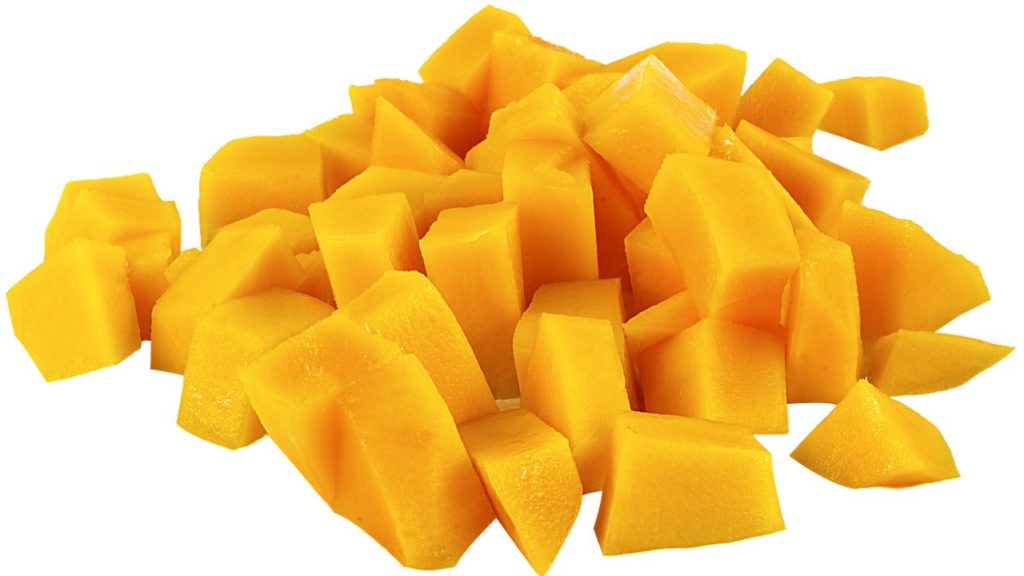
It is important to note that many fruits are high in natural sugars, so it is recommended that you only include fruits in your bearded dragon’s diet as an occasional treat (or for training purposes).
Safe Fruits
It is safe to feed your dragon mango, papaya, grapes, or blueberries as a treat or reward, as long as it’s not too often and you don’t give them too many. It is also safe to include the occasional slice of melon or banana as a fruity treat. Apples, cranberries, strawberries, and watermelon are also safe options, should you wish to vary your bearded dragon’s treats from time to time.
Non-Safe Fruits
Oranges, Lemons, Limes, and Tomatoes are highly acidic and, along with other citrus fruits (or even rhubarb), are not recommended as a staple of your dragon’s diet. Avocadoes are too high in fat and are technically toxic in nature, so it is not recommended that you feed your dragon these fruits, either.
Foods To Avoid (At All Costs!)
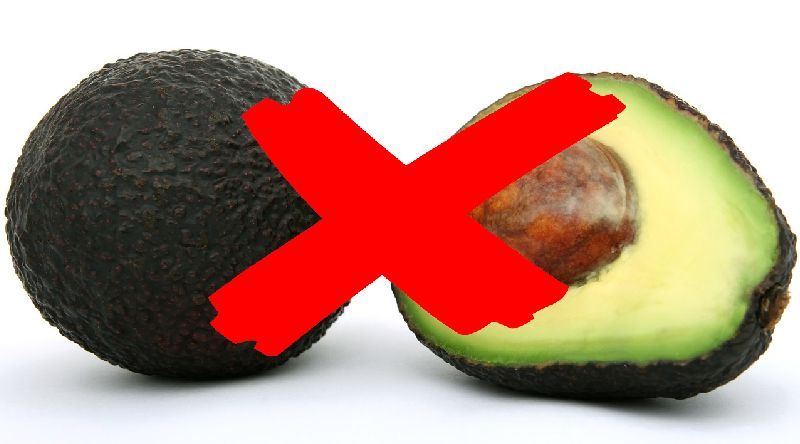
There are some specific foods that you should never feed you bearded dragon. Here are a few that you should at all costs:
- Avocados: High in fat and very toxic to bearded dragons.
- Spinach: Inhibits the binding of calcium, which can lead to deficiencies in your bearded dragon.
- Beet Tops: Can be toxic to bearded dragons.
- Tomatos: To acidic for bearded dragons. Can be fed in moderation, but probably best avoided.
- Lettuce: Not the worst food on our list, but offers zero nutritional value.
- Rhubarb: Known to be toxic to bearded dragons.
- Acidic fruits (Lemon, Oranges, Grapefruits, etc.): Can be toxic to bearded dragons.
- Fireflies: Extremely toxic to bearded dragons! Avoid at all costs.
- Wild-caught insects: Wild-caught insects can very easily infect your bearded dragon with parasites and diseases. You should never feed your beardie anything that you catch yourself.
How Often Should Bearded Dragons Eat?
As babies, bearded dragons will often eat multiple meals a day at pretty regular intervals. They tend eat less often as they age, sometimes choosing to eat only once every couple days.
This is perfectly normal and nothing to worry about – though it is suggested that you make fresh salads available to them every day, should they need a little snack.
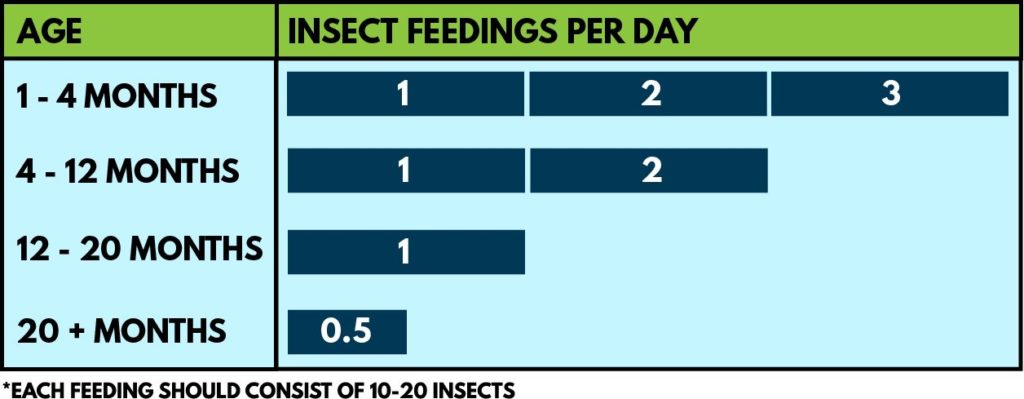
To summarize the image above, here is a rough guide for insect feeding intervals based on your bearded dragon’s age:
- 1-4 Months Old: 3 feedings per day
- 4-12 Months Old: 2 feedings per day
- 12-20 Months Old: 1 feeding per day
- 20+ Months Old: 1 feeding every other day
Once your bearded dragon is over two years old, you can even reduce feedings down to every 2 days. Once again, this is purely a rough guide – if your beardie really likes to eat, you can still feed every day/every other day (even in older age).
It is also important to keep in mind that dragons can be highly sensitive to changes in their diet, so as you’re shifting from the younger dragon’s diet to a diet more suitable for an older dragon, your dragon may not eat for a couple days.
This isn’t detrimental to their health in any way, and can actually be quite common. If this is the case for your dragon, experts recommend giving your dragon a warm soak.
Avoided Food-Related Health Issues
Much like the body of a human, the body of a bearded dragon can suffer from many diseases and ailments (such as liver failure, gout, cancer, or even periodontitis aka gum disease).
Keeping their diets rich in nutritious alkaline foods (fresh greens and vegetables) will help keep your bearded dragon in optimal health.
As we have stated a few times above, it is also be beneficial to include a calcium supplement and a multivitamin to their meals – these can help strengthen their skeletal structure, prevent Metabolic Bone Disease, and improve their nervous system.
Bearded Dragons tend to be aggressive eaters and may consume dangerous/large objects, so it is your responsibility to make sure any potentially hazardous materials are kept out of reach of your pet.
The most common food-related health issue is impaction. This happens when bearded dragons eat sand, rocks, or other non-organic substances along with their food. The avoid this issue, make sure to use a safe substrate such as reptile carpet or tank liner.
The Importance of Calcium and Multivitamin Supplements
It is equally important to supplement your dragon’s diet as it is to get their diet right in the first place. Sprinkling their insects with a high quality calcium supplement such as Repti Calcium or Nutrobal will be beneficial to their diets.
You may find that lightly misting the insects with water first will help the powder stick a little better. Including a multivitamin like Repashy’s Supervite a few times a week will provide the perfect nutritional boost to their meals.
Soaking Your Bearded Dragon
Soaking your dragon in warm water for just 10-15 minutes will help them to stay hydrated and relaxed. In addition, these quick soaks will also keep their digestive system running smoothly and help relieve constipation.
Remember – Dry your bearded dragon thoroughly when they’ve finished their soak. Not drying your bearded dragon thoroughly can mess with humidity levels in your tank (which is something that you definitely want to avoid).
Helpful Feeding Tips
Getting your Bearded Dragon to eat isn’t always easy! Even if you have the perfect foods prepared, there’s a chance that your bearded dragon may be a bit stubborn. Here are some great feeding tips to keep in mind:
1. Dizzy the insects before feeding
When feeding baby bearded dragons, it is recommended that you dizzy the insects before feeding them to your pet. To do this, just recycle an old container (maybe a tubular cardboard oatmeal box or a large Ziploc baggie), toss the live feeder insects into this container with a dusting of calcium powder, and give them a little shake for a few seconds.
Keep in mind that the insects should still be alive when you feed them to your dragon (so try not to shake them too hard).
This practice makes the insects much easier to catch, which can be very helpful for clumsy baby beardies.
2. Control the portions
Also important when feeding your bearded dragon their insects is to limit the portions of insects. Only feed as much as your bearded dragon can eat in 5-10 minutes
At meal time, your bearded dragon should eat all live insects in a single setting. Don’t let a ton of insects swarm around your tank!
3. Prepare foods correctly
There are some fruits and veggies that will require a little extra preparation before being fed to your bearded dragon. Taking the peels off vegetables or cutting them down into more manageable bite-sized pieces should make them safer and easier to eat. You really only need to do this if the peels are really tough/hard to digest.
4. Moderation and diversification are key
When building your bearded dragon’s meal plan, it is also important to remember to feed them everything in moderation. Rather than offering the same salad mix every single day, try alternating with an assortment of different veggies every couple weeks. This will get them used to eating different foods and help them adapt to other changes within their tank.
Also, in diversifying their vegetables, you will help your bearded dragon receive a good balance of all the necessary vitamins. Too much of one vegetable and not enough of certain others might lead to hyper or hypo-vitaminosis (which is a condition that occurs when dragons get too many or too few vitamins). Rotating their veggies will keep their vitamin intake at the right levels.
5. Make greens more appealing
Another good feeding practice is keeping your bearded dragon’s meals full of fresh greens. Dried, bagged, or preserved foods lack the necessary nourishment to satisfy the dietary needs of your pet.
It is key that your greens are fresh – fresh and organic produce will help your bearded dragon receive the best percentage and concentration of essential vitamins, minerals, and key nutrients that are required to build up both their immune system (for fighting off infections) and their digestive system (which will effectively eliminate waste).
The failure of either of these systems could result in disease, parasites, or other deteriorating health conditions (so it’s vital that you help your bearded dragon keep them up and running).
To make sure salads are appealing to your dragon, it can be a good idea to add different colors and textures to the mix.
Fresh chopped green beans, Konnayu (purple yams), or shaved butternut squash can provide a colorful assortment and varied texture to their meal.
If your dragon hasn’t been eating, it is also okay to drop in a few worms to coax your pet back into a more regularly timed feeding schedule.
Things To Know About Feeder Insects
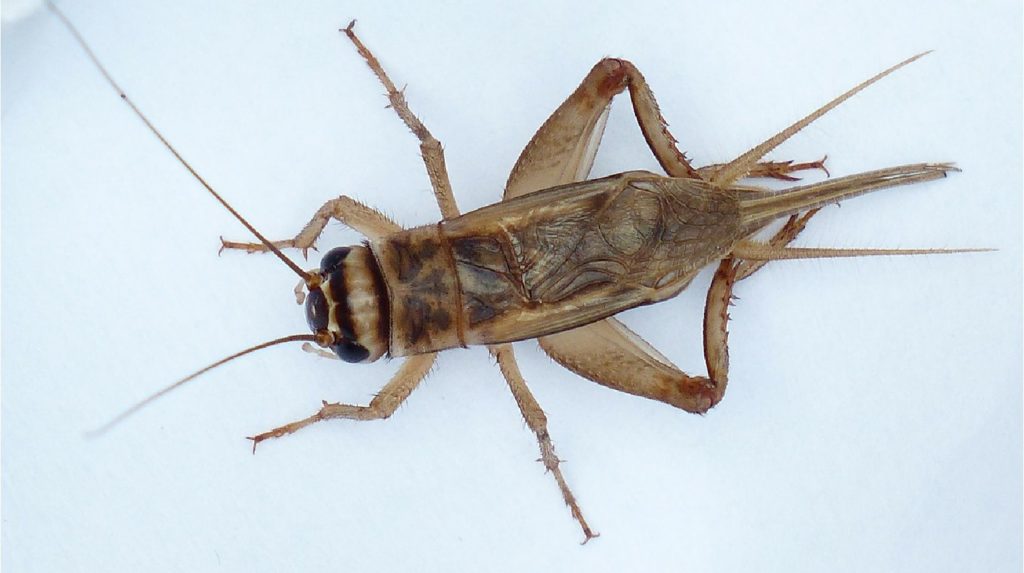
Every variety of feeder insects requires different care and handling. Consulting with your supplier will give you the opportunity to learn all you need to know about important aspects of the insects’ care (like the storage requirements of whichever type you’re working with). It is also necessary that you feed your bearded dragon live, “gut loaded” feeder insects.
“Gut-loading” is the technical term referring to the process of feeding your insects in a healthy way so that your dragon can reap the dietary benefits (since your bearded dragon is essentially eating whatever your feeder insects are eating). Make sure to ask about the supplier of your feeder insects and the source of the food they have been/are eating.
Important: Don’t ever feed your dragon common insects from your backyard or garden, as it is impossible to know what they’ve been eating or which parasites and/or pesticides they might have come into contact with.
Depending on where you and your bearded dragon are located, the availability for specific types of insects can vary widely.
In Florida, for example, Dubia Roaches illegal to own. In Canada, you’ll run into the same problem, though both Canada and Florida should still allow the purchase of Discoid Roaches (a good alternative).
To find out more about what is offered in your community, just check with your local breeder or a reptile store in the area and ask if there are any restrictions or available alternatives that you should be aware of.
Common Feeding Mistakes
Here are a few common mistakes that owners make when feeding their new bearded dragon:
Only Feeding Crickets
While it is very common among bearded dragon owners to feed their pets crickets as a staple insect, they usually aren’t the absolute best option. Uneaten crickets can be loud, a bit smelly, and can potentially try to bite/chew on your bearded dragon if left in the cage.
Roaches are the nutritionally superior option and usually far less likely to carry parasites (a single roach nymph is the equivalent of two crickets). Crickets should only be used as a staple if nothing else is available to you for the time being (or if your dragon is an especially picky eater).
Only Feeding Mealworms
Another common mistake is feeding bearded dragons mealworms as their staple insect. These worms are simply empty calories for your bearded dragon and can be difficult to digest with their hard outer shells. Overall, mealworms are not worth the time or effort it would take your bearded dragon to consume them.
Using The Wrong Substrate
Bearded dragons can accidentally ingest some of the substrate around the food they’re eating. It is more often a problem for younger bearded dragons, so it is not recommended that owners feed their smaller dragons in tanks with loose substrate (like sand).
If consumed, substrate can cause a build-up inside your pet because it can’t be digested (otherwise known as impaction). This often leads to a blockage that can be fatal. Older bearded dragons are usually more accurate eaters, but it is still recommended to use a safe substrate.
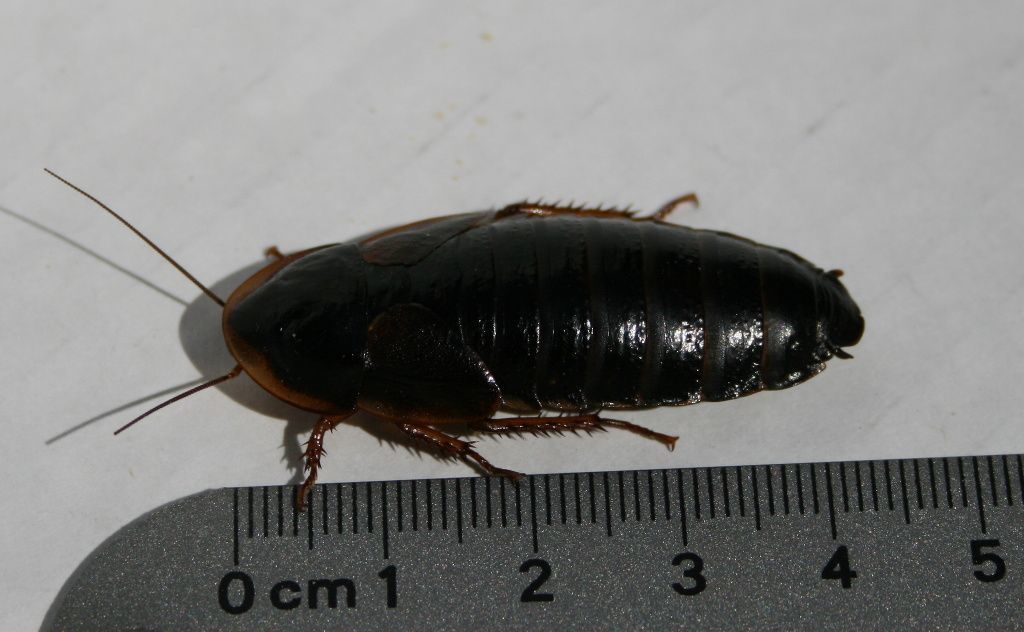
How can I prepare Yucca Root for my beardie? I’ve heard it contains cyanide when raw so I’m assuming boil it then shave or mash? Also, how often can I give this with his daily salad? Thank you!